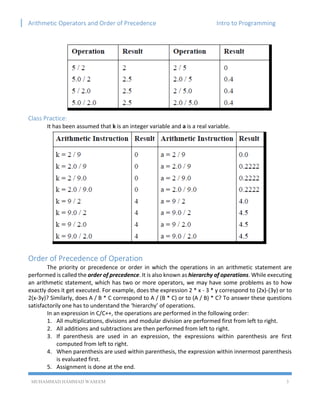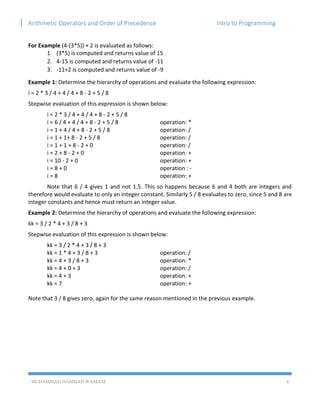[ITP - Lecture 06] Operators, Arithmetic Expression and Order of Precedence
- 1. Arithmetic Operators and Order of Precedence Intro to Programming MUHAMMAD HAMMAD WASEEM 1 Arithmetic Operators The arithmetic operators are the symbols that represent arithmetic operations. These are used in arithmetic expressions. Each arithmetic operators upon two numeric values (constants or variables) and return a value. The following arithmetic operators are used in C++. Addition (+) Subtraction (-) Multiplication (*) Division (/) For remainder (%) All arithmetic operators, except the remainder operator, are used for all type of numeric data. A C arithmetic instruction consists of a variable name on the left hand side of = and variable names & constants on the right hand side of =. The variables and constants appearing on the right hand side of = are connected by arithmetic operators like +, -, *, and /. The variables and constants together are called ‘operands’ that are operated upon by the ‘arithmetic operators’ and the result is assigned, using the assignment operator, to the variable on left- hand side. A C arithmetic statement could be of three types. These are as follows: Integer mode arithmetic statement - This is an arithmetic statement in which all operands are either integer variables or integer constants. Ex.: int i, king, issac, noteit; i = i + 1; king = issac * 234 + noteit - 7689 ; Real mode arithmetic statement - This is an arithmetic statement in which all operands are either real constants or real variables. Ex.: float qbee, antink, si, prin, anoy, roi; qbee = antink + 23.123 / 4.5 * 0.3442 ; si = prin * anoy * roi / 100.0 ; Mixed mode arithmetic statement - This is an arithmetic statement in which some of the operands are integers and some of the operands are real. Ex.: float si, prin, anoy, roi, avg; int a, b, c, num ; si = prin * anoy * roi / 100.0 ; avg = ( a + b + c + num ) / 4 ; It is very important to understand how the execution of an arithmetic statement takes place. Firstly, the right hand side is evaluated using constants and the numerical values stored in the variable names. This value is then assigned to the variable on the left-hand side.
- 2. Arithmetic Operators and Order of Precedence Intro to Programming MUHAMMAD HAMMAD WASEEM 2 Though Arithmetic instructions look simple to use one often commits mistakes in writing them. Let us take a closer look at these statements. Note the following points carefully. a) C allows only one variable on left-hand side of =. That is, z=k*l is legal, whereas k*l=z is illegal. b) In addition to the division operator C also provides a modular division operator. This operator returns the remainder on dividing one integer with another. Thus the expression 10 / 2 yields 5, whereas, 10 % 2 yields 0. Note: the modulus operator (%) cannot be applied on a float. Also note that on using % the sign of the remainder is always same as the sign of the numerator. Thus –5 % 2 yields –1, whereas, 5 % -2 yields 1. c) An arithmetic instruction is often used for storing character constants in character variables. char a, b, d ; a = 'F'; b = 'G'; d = '+'; When we do this the ASCII values of the characters are stored in the variables. ASCII values are used to represent any character in memory. The ASCII values of ‘F’ & ‘G’ are 70 & 71 (refer ASCII Table). d) Arithmetic operations can be performed on ints, floats and chars. char x, y ; int z ; x = 'a'; y = 'b'; z = x + y; Thus the statements, are perfectly valid, since the addition is performed on the ASCII values of the characters and not on characters themselves. The ASCII values of ‘a’ and ‘b’ are 97 and 98, and hence can definitely be added. e) No operator is assumed to be present. It must be written explicitly. In the following example, the multiplication operator after b must be explicitly written. a = c.d.b(xy) //usual arithmetic statement b = c * d * b * (x * y) //C statement f) Unlike other high level languages, there is no operator for performing exponentiation operation. Thus following statements are invalid. a = 3 ** 2; b = 3 ^ 2; Integer and Float Conversions In order to effectively develop C programs, it will be necessary to understand the rules that are used for the implicit conversion of floating point and integer values in C. These are mentioned below. Note them carefully. a) An arithmetic operation between an integer and integer always yields an integer result. b) An operation between a real and real always yields a real result. c) An operation between an integer and real always yields a real result. In this operation the integer is first promoted to a real and then the operation is performed. Hence the result is real. I think a few practical examples shown in the following figure would put the issue beyond doubt.
- 3. Arithmetic Operators and Order of Precedence Intro to Programming MUHAMMAD HAMMAD WASEEM 3 Class Practice: It has been assumed that k is an integer variable and a is a real variable. Order of Precedence of Operation The priority or precedence or order in which the operations in an arithmetic statement are performed is called the order of precedence. It is also known as hierarchy of operations. While executing an arithmetic statement, which has two or more operators, we may have some problems as to how exactly does it get executed. For example, does the expression 2 * x - 3 * y correspond to (2x)-(3y) or to 2(x-3y)? Similarly, does A / B * C correspond to A / (B * C) or to (A / B) * C? To answer these questions satisfactorily one has to understand the ‘hierarchy’ of operations. In an expression in C/C++, the operations are performed in the following order: 1. All multiplications, divisions and modular division are performed first from left to right. 2. All additions and subtractions are then performed from left to right. 3. If parenthesis are used in an expression, the expressions within parenthesis are first computed from left to right. 4. When parenthesis are used within parenthesis, the expression within innermost parenthesis is evaluated first. 5. Assignment is done at the end.
- 4. Arithmetic Operators and Order of Precedence Intro to Programming MUHAMMAD HAMMAD WASEEM 4 For Example (4-(3*5)) + 2 is evaluated as follows: 1. (3*5) is computed and returns value of 15 2. 4-15 is computed and returns value of -11 3. -11+2 is computed and returns value of -9 Example 1: Determine the hierarchy of operations and evaluate the following expression: i = 2 * 3 / 4 + 4 / 4 + 8 - 2 + 5 / 8 Stepwise evaluation of this expression is shown below: i = 2 * 3 / 4 + 4 / 4 + 8 - 2 + 5 / 8 i = 6 / 4 + 4 / 4 + 8 - 2 + 5 / 8 operation: * i = 1 + 4 / 4 + 8 - 2 + 5 / 8 operation: / i = 1 + 1+ 8 - 2 + 5 / 8 operation: / i = 1 + 1 + 8 - 2 + 0 operation: / i = 2 + 8 - 2 + 0 operation: + i = 10 - 2 + 0 operation: + i = 8 + 0 operation : - i = 8 operation: + Note that 6 / 4 gives 1 and not 1.5. This so happens because 6 and 4 both are integers and therefore would evaluate to only an integer constant. Similarly 5 / 8 evaluates to zero, since 5 and 8 are integer constants and hence must return an integer value. Example 2: Determine the hierarchy of operations and evaluate the following expression: kk = 3 / 2 * 4 + 3 / 8 + 3 Stepwise evaluation of this expression is shown below: kk = 3 / 2 * 4 + 3 / 8 + 3 kk = 1 * 4 + 3 / 8 + 3 operation: / kk = 4 + 3 / 8 + 3 operation: * kk = 4 + 0 + 3 operation: / kk = 4 + 3 operation: + kk = 7 operation: + Note that 3 / 8 gives zero, again for the same reason mentioned in the previous example.




